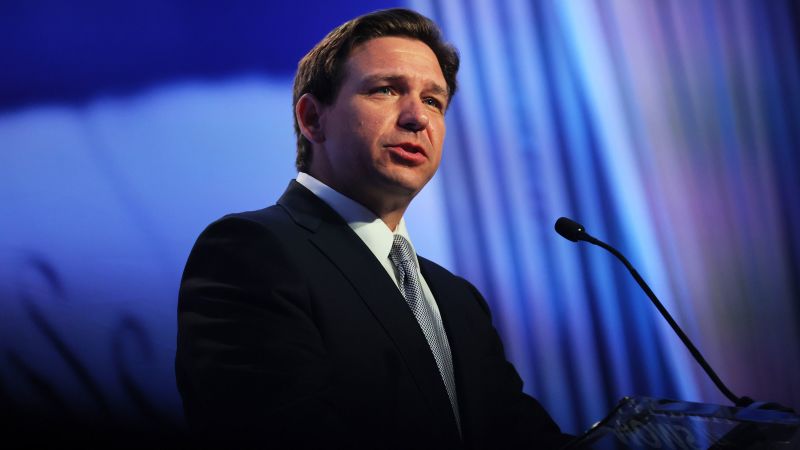CNN
—
The first full financial look at the 2024 presidential race came into focus over the weekend as candidates filed campaign finance reports with federal regulators. They highlight potential trouble spots for Florida Gov. Ron DeSantis, a skeletal campaign operation for the current White House occupant and a wide chasm between the early fundraising leaders in the Republican primary and the rest of the field.
The filings also show at-risk Senate Democrats continuing to amass big sums as they scramble to defend their party’s narrow majority next fall. Republican freshmen in competitive House seats, meanwhile, demonstrated a strong start.
Here are takeaways from the second-quarter fundraising reports for the three months ending June 30.
The Florida governor raised $20 million – a strong total – but his campaign is burning through cash at a rapid rate, spending nearly $8 million since he entered the contest in late May, according to its filing Saturday with the Federal Election Commission.
Travel and payroll expenses each topped $1 million, and more than $800,000 went to digital fundraising consulting, according to the campaign’s report. As of the end of June, DeSantis employed 90 people, compared to nearly 40 people employed by the campaign of former President Donald Trump, the current GOP primary front-runner.
On Saturday, a DeSantis campaign aide confirmed that the team had recently trimmed some staff.
“Defeating Joe Biden and the $72 million behind him will require a nimble and candidate driven campaign, and we are building a movement to go the distance,” campaign spokesperson Andrew Romeo said in a statement.
The latest filing underscores another warning sign for DeSantis: A small share – less than 15% – of his contributions from individuals came in amounts of $200 or less. Robust small-dollar donations can offer a sign of grassroots momentum behind a campaign, and supporters who contribute small amounts can be tapped repeatedly for donations before hitting the maximum $3,300 an individual can legally donate in primary elections.
DeSantis entered the second half of the year with $12.2 million remaining in the bank, but only about $9 million of that is available for spending in the GOP primary. DeSantis collected some $3 million in general election money from maxed-out donors that can only be spent if he secures his party’s nomination.
In a Fox News interview Sunday, DeSantis defended his campaign’s finances, saying, “We raised more money than Joe Biden did in the second quarter, who’s the sitting president, and we raised more money than Donald Trump did into his campaign who, of course, was the former president.” But the Biden campaign also has access to the resources of the Democratic National Committee as he seeks a second White House term.
Trump spokesman Steven Cheung, citing the staff cuts announced by the DeSantis campaign, said the Florida governor has “clearly mismanaged his supporters’ donations.”
“If he can’t even run his own campaign correctly, how can he run a country?” Cheung said.
This weekend’s reports also underscore a stark divide between those who raised substantial sums – such as Trump and DeSantis – and the other well-known political figures competing for the GOP nod.
Former Vice President Mike Pence languished at the bottom half of the pack, bringing in a less than $1.2 million, the filings show. He entered the 2024 race in the first week of June, with a little more than three weeks remaining in the fundraising quarter but had spent months preparing a bid. His paltry numbers raise questions about whether he can gain traction among the party faithful.
Nearly 30% of contributions from individuals to Pence came from people who donated $200 or less. Former New Jersey Gov. Chris Christie outraised the former vice president – bringing in more than $1.65 million during the first 25 days of his candidacy – and took in more a third of his individual contributions in these smaller amounts.
Notably, North Dakota Gov. Doug Burgum, who is largely self-financing his campaign, took in more money from contributors – nearly $1.6 million – than Pence did. (Burgum, a former software executive, is working hard to lure donors, offering $20 gift cards for donations of at least $1 as tries to meet the contributor threshold to qualify for the first GOP debate next month.)
Trump, who leads the GOP field in polling, raised $17.7 million during the quarter – most of which was transferred from a joint fundraising committee that also sends donations to a leadership PAC, Save America.
Save America has paid the former president’s legal expenses in the past; Trump now has been indicted twice this year – first by a Manhattan grand jury in connection with an alleged hush-money scheme and then by a federal grand jury, related to allegations that he mishandled classified documents after leaving the White House. He has denied any wrongdoing.
Trump’s campaign previously announced raising a total of $35 million in the second quarter through his joint fundraising operation. But the full picture on how that money was divided and spent won’t become apparent until later this month when additional reports are filed.
Trump reported $22.5 million in cash on hand as of June 30, topping the GOP field. In second place, with $21.1 million, was South Carolina Sen. Tim Scott – who transferred big sums from his Senate campaign account to his presidential operation.
Former South Carolina Gov. Nikki Haley entered July with more than $6.8 million the bank, putting her in the middle of the GOP pack.
Biotech entrepreneur Vivek Ramaswamy, meanwhile, continues to plow his personal fortune into the contest, loaning his campaign another $5 million in the second quarter, the reports show. He started July with more than $9 million in cash reserves – money he can easily replenish if he continues to spend heavily to introduce himself to the GOP electorate.
Biden has announced raising $72 million with the DNC, which reports its fundraising later in the week. But that total haul is nearly as much money as what all the major GOP contenders combined reported collecting in their main campaign accounts during the second quarter.
Despite talking up the big numbers he’s raised with the DNC, Biden’s campaign is a bare-bones operation, his new filing shows – a slow start that’s sure to only deepen worries among some Democrats about the president’s reelection preparations.
The Biden campaign, which officially launched in April, spent just $1.1 million in the second quarter and employed exactly four staffers as of the end of June, FEC records show. By contrast, in the same window in 2011, President Barack Obama’s campaign had spent more than $11 million on his reelection effort.
The 2024 Senate map favors Republicans, and vulnerable Democratic incumbents continue to raise big sums as they prepare to defend their narrow majority in the chamber.
Montana Sen. Jon Tester – who, along with fellow Democratic Sens. Joe Manchin and Sherrod Brown, is up for reelection next year in a state won twice by Donald Trump – raised more than $5 million in the April-to-June fundraising period. His campaign touted that haul as his best second quarter in a nonelection year. He started July with $10.5 million in cash reserves.
One potential Tester challenger, GOP Rep. Matt Rosendale, raised about $443,000 through his House campaign committee and started July with $1.5 million in available cash, which can be transferred to a Senate bid. The Republican establishment has already begun lining up behind another contender, retired Navy SEAL and aerospace CEO Tim Sheehy, who announced his candidacy just days before the end of the fundraising quarter.
In West Virginia, Manchin – a top target for Republicans – has not announced whether he will seek a third term next year, but his fundraising picked up pace significantly during the second quarter as he collected nearly $1.3 million – up from just $370,000 during the first three months of the year.
Manchin’s second-quarter haul bested the amounts raised by the top Republicans in the race, Gov. Jim Justice and Rep. Alex Mooney. And Manchin had more than $10.7 million in his campaign coffers on June 30 to Mooney’s $1.5 million and Justice’s $808,000.
In Ohio, Brown raised $5 million during the quarter with the three-term senator reporting $8.7 million in hand as of the end of June.
Brown’s fundraising bested that of his Republican challengers: Businessman Bernie Moreno raised nearly $2.3 million, and state Sen. Matt Dolan took in $1.3 million during the quarter – $1 million of which was a loan from the candidate. Dolan’s family owns the Cleveland Guardians baseball team.
“Democrats have a stronger small-donor base” than Republicans do, and they are using the advantage of incumbency to get a jump start in building their campaign war chests, said Jacob Rubashkin, an analyst with Inside Elections, a nonpartisan political newsletter. It’s one reason, he added, that GOP leaders in Washington have sought to recruit wealthy challengers who can self-fund their Senate bids.
And Rubashkin noted that Republican challengers are still emerging.
Earlier this month, for instance, retired Navy Capt. Sam Brown announced plans to enter the GOP Senate primary in Nevada in the hopes of taking on Democratic Sen. Jacky Rosen next fall.
Brown’s candidacy gave Republicans a significant recruit in a key swing state. Rosen raised $2.7 million during the second quarter, new filings show, with nearly $7.5 million in available cash, heading into July.
Democratic Senate incumbents in other key states also raised substantial amounts in the second quarter, including Pennsylvania’s Bob Casey, who brought in $4 million, and Wisconsin’s Tammy Baldwin, who raised $3.3 million.
One sign of the small-dollar enthusiasm among Democrats: The nearly $6.2 million raised by Texas Rep. Colin Allred in his bid to take on GOP Sen. Ted Cruz. The Dalla-area congressman also transferred more than $2.4 million from his House campaign account during the quarter – adding to his topline haul.
Nearly half – about 48% – of the money Allred raised from individual donors came in amounts of $200 or smaller, according to his report.
Cruz raised a little more than $3.3 million and had nearly $4.8 million in available cash as of June 30. Only about 30% of Cruz’s individual contributions came from donors who gave in small amounts.
While Democrats are putting their party in a strong financial position to defend its Senate majority, House Republicans are also hauling in cash while seeking to defend their control of the chamber.
Eight of nine freshman Republicans in House districts rated as “toss ups” by The Cook Political Report raised between $500,000 and $1 million in the second quarter, a strong showing in an off-year for federal elections. And five had stockpiled at least $1 million in cash on hand as they prepare for competitive reelection contests.
Meanwhile, freshman Democrats in “toss up” districts reported less impressive numbers – among the seven members in those seats, only three raised more than $500,000, and just one, Rep. Marie Gluesenkamp Perez of Washington state, ended the quarter with more than $1 million in cash on hand.
This story and headline have been updated with additional information.
Sumber: www.cnn.com






